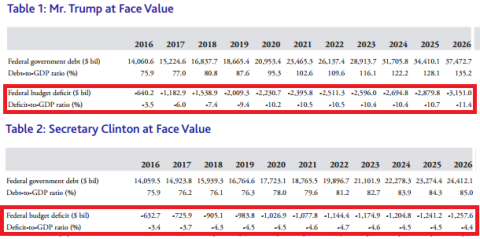Moody’s is out with a new analysis on the Clinton and Trump economic plans.¹ The short story is, Moody’s says the Clinton plan is superior to the Trump plan generating 2.6% RGDP for Clinton vs 0.6% RGPD for Trump in their first terms. But there’s a potential flaw in the Moody’s report in which they assume that a larger budget deficit hurts growth and causes rates to rise due to the crowding out myth. Of course, this is a common myth in mainstream economics that results from the usage of a loanable funds model of the economy. And as I’ve explained on so many occasions, that model is wrong when applied to an endogenous money system. It’s also clear, from 20+ years of rising national debt, that higher government debt levels do not necessarily lead to higher interest rates.
Once you back out that assumption the story looks different. What if, as I’ve theorized now for 7+ years, this economy actually needs higher deficits? What if household balance sheets remain weak enough that the injection of a huge amount of government net financial assets actually boosts growth because it supplies the private sector with super safe assets that restore the health of their balance sheets from the credit bust? If this theory is right then Trump’s plan is the stimulative dream every Keynesian has been waiting for because it blows out the national debt and increases the budget deficit to 10%+ of GDP in the next 4 years. Here’s the side by side comparison from the Moody’s report:
It’s all very strange if you ask me. Clinton is the Conservative fiscal candidate here and Trump is not just a Liberal, he’s a super Liberal. And all of this puts someone like me in a very strange position. As an Independent and probably a moderate Libertarian I find Trump’s social positions abhorrent and regressive. In addition, his biggest policy proposals don’t even solve the issues he claims they will.² But as a Keynesian (yeah, a real Keynesian, not the mythical reckless socialist “Keynesian” you read about on the internet) I look at Trump’s figures and conclude that they’d probably be more stimulative than Clinton’s because Clinton is actually the austerity candidate whereas Trump is the government deficit candidate.
² – Specifically, Mr. Trump’s biggest policy ideas can be described as three pronged – 1) Build a wall to resolve our illegal immigration problem; 2) Enact trade barriers to bring back jobs; and 3) Ban Muslims and “destroy” ISIS. These all fail a basic common sense test. The wall is a waste of money since most illegal immigrants enter the USA legally and don’t encounter the ground border at all. Regarding trade, Trump’s ideas are also silly. Tariffs and trade barriers cannot solve the loss of manufacturing jobs overseas because the main cause of the decline in those jobs is automation and a shrinking of the size of the manufacturing economy in the USA. Those jobs are gone and Trump’s plans would be an expensive and wasted attempt to bring back jobs that are never coming back to the USA. Thirdly, Trump’s plan to “destroy” ISIS and ban Muslims is both unconstitutional and void of sensible solutions. We aren’t fighting “ISIS”. The world is fighting against radicalized Muslims. It’s impossible to estimate the exact number of Muslims who have been radicalized, but it’s safe to say that it’s a large number well into the millions of people. But to attack these people is to confirm the very belief they have – that the West is at war with them. Destroying ISIS doesn’t destroy this belief or the radlicalized minority of Muslims. If anything it reaffirms their views. Cut off the ISIS head and a new one will appear under a different banner. In short, Trump’s most grandiose policy ideas are hot air. And his fiscal plan is strangely Liberal. How did this guy win the Republican nomination again?
Mr. Roche is the Founder and Chief Investment Officer of Discipline Funds.Discipline Funds is a low fee financial advisory firm with a focus on helping people be more disciplined with their finances.
He is also the author of Pragmatic Capitalism: What Every Investor Needs to Understand About Money and Finance, Understanding the Modern Monetary System and Understanding Modern Portfolio Construction.


